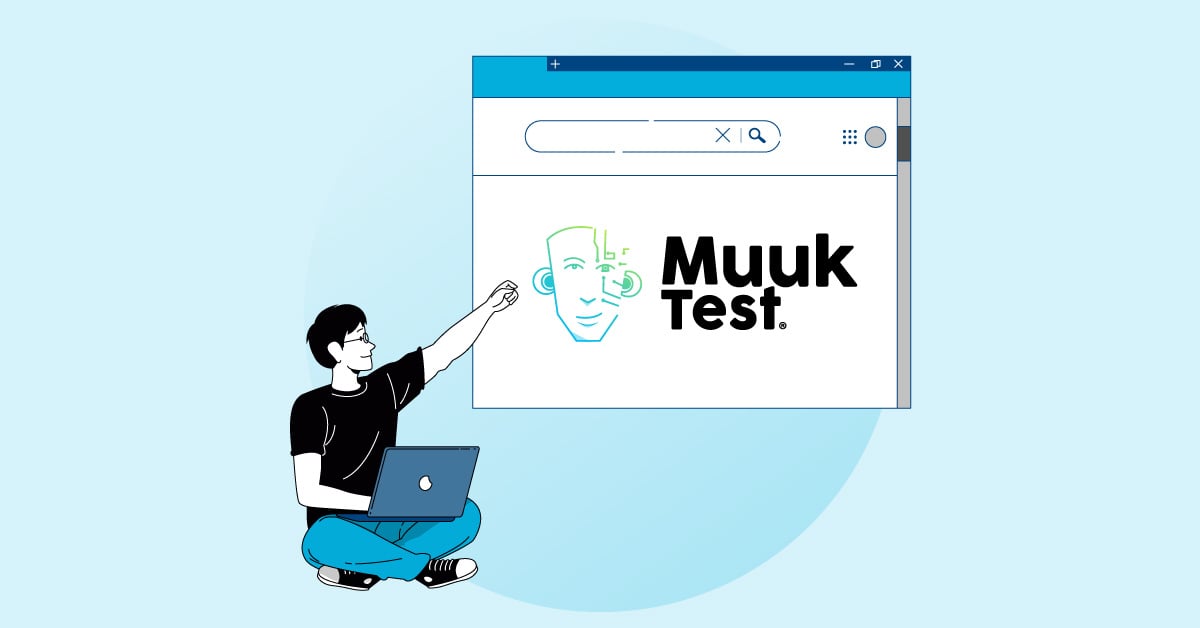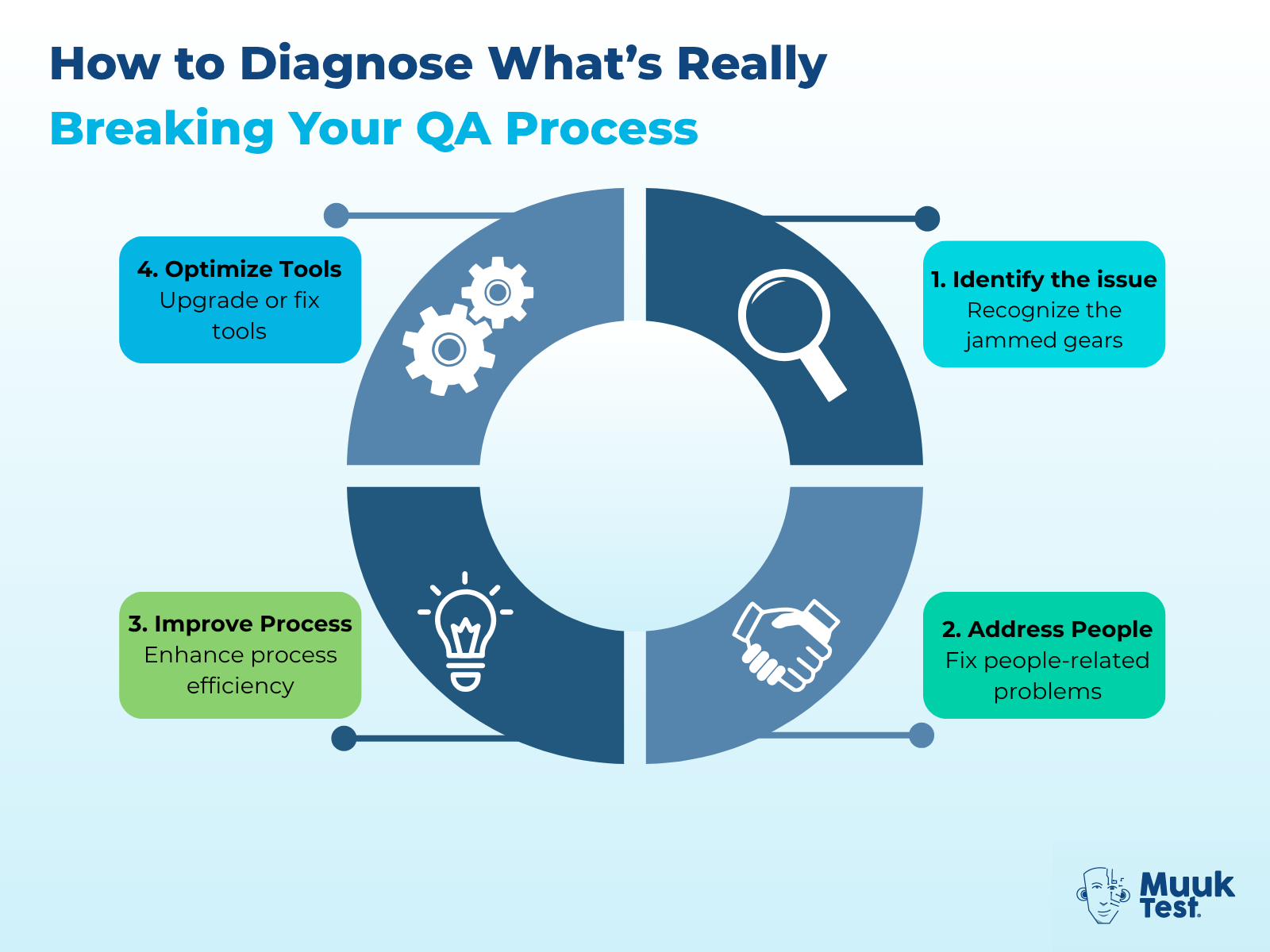- Fixing QA is about rebuilding trust. Most QA failures stem from misalignment between people, processes, and tools, not the tools themselves. Start by diagnosing where confidence breaks down.
- Focus on predictability before perfection. Stabilize your tests and create a confidence baseline. Small, reliable wins build momentum faster than massive overhauls.
- Communication is your strongest QA tool. Teams recover faster when they share progress, celebrate small wins, and align stakeholders on risks.
- Culture repair beats code repair. Real QA recovery happens when developers, testers, and leaders share ownership of quality, turning “QA failed” into “our signal needs work.”

When everything feels broken with flaky tests, unstable builds, burned-out testers, and frustrated engineers, it is tempting to throw away your entire QA process and start again.
But real QA leadership isn’t about hitting the reset button. It is about triaging, figuring out what to fix first, and rebuilding confidence from the inside out, alongside learning from mistakes.
This blog draws from real QA recovery experiences and insights from industry leaders such as MuukTest, Thoughtworks, and QA Ltd, alongside lessons from top testing speakers and practitioners who’ve rebuilt quality cultures under pressure.
Before reaching for new frameworks or AI dashboards, take a hard look at where your QA is actually failing.
Most “broken” QA teams collapse under one of three pressures: people, process, or tools.
People
- Testers are firefighting constantly, without clarity or ownership.
I have seen teams where testers spend more time chasing clarity of a functionality than actually testing. Too often, information lives in silos, making quality an afterthought rather than a shared goal. The fix is in collaboration; when you consider testers as part of the engineering team, they become integral to the build process, not an after-step.
- Developers stop trusting test results or QA itself.
Many times in data science projects I've been involved in, developers have told us, "We've tested it; we don't need you to do it again." However, during exploratory testing, my team has found bugs that could impede releases.
- Leadership sees QA as a bottleneck rather than a value enabler.
Too often, QA is seen as a bottleneck rather than an enabler. But QA is the safeguard for team quality and customer trust. When teams “shift left” and involve QA early (days or even weeks before release), the payoff is faster delivery, fewer last-minute surprises, and a culture that values stability as much as speed.
Simple Fix: Bring focus back to visibility and trust.
In his research, Diego Lo Giudice highlights that QA confidence grows from predictable outcomes rather than perfect results. Therefore, start with small wins, such as visible priorities, clear test ownership, and cutting out noise.
Process
- Tests run too late in the lifecycle.
Shift left with testing where possible, involve QA sooner.
- Feedback loops stretch for days.
Try CI/CD pipelines with automation, integration tests, and accessibility tests. In my experience, this helps us a lot with feedback loops and confidence.
- Regression testing becomes a release blocker.
When pipelines run, they can take a while, especially with multiple suites covering front-end, back-end, performance, and accessibility tests. Instead of waiting idly or running every regression test on autopilot, use that time strategically. Focus on high-impact user journeys through exploratory regression. Prioritize what matters most to product confidence, not just test count.
Simple Fix: Map your feedback flow.
As outlined in MuukTest’s case study on targeted smoke testing, MuukTest’s recovery playbooks emphasize accelerating feedback by running fast smoke suites early in the pipeline to validate critical paths before full regression. When flaky end-to-end suites block deployments, the best move is to quarantine them and rebuild confidence with smaller, stable test sets that deliver quick, reliable signals.
Tools
- Outdated frameworks, missing observability, and unmanaged test data all add invisible drag.
From the very start of any project, make observability part of your QA strategy. When my team began integrating observability tools, we were included in every demo and discussion, which meant we could use the same data and insights to strengthen our testing. It turned testing from a reactive task into a proactive, data-driven practice.
- But it’s not always the tool—the real issue is often maintenance debt.
Every team carries some level of technical or QA debt, and that’s normal. What matters is how you prioritize it. Align your team around a clear vision and shared values, and let those guide what you build and maintain. When your priorities are intentional, quality naturally follows.
Simple Fix: Run a tool impact audit, not a tool replacement project.
Top QA consultancies like EPAM and Cigniti advise assessing ROI and the overlap between test coverage before adding more frameworks. The most effective QA transformations connect a few reliable tools well, not all tools loosely.
Step 2. Create a QA Recovery Action Plan
When instability dominates, your first goal isn’t perfection; it's predictability. Think of this as a “QA triage sprint,” lasting 2–3 weeks, to rebuild stability and signal.
Stability
- Quarantine flaky tests
- Rerun failures in isolation to validate defects.
- Build a “stable core suite” that defines your new confidence baseline.
Test Confidence
- Shift from binary pass/fail to confidence metrics, something more qualitative.
- Track false failure rate, rerun stability, and release-blocking tests.
- Build a small confidence dashboard like one environment, one data source, one truth (a single source of truth).
Team Focus
- Reduce scope temporarily.
- Celebrate small, visible recoveries and showcase them in your show-and-tell sessions.
- Over-communicate progress up and across teams.
Step 3. Rebuild Executive and Team Trust During QA Recovery
As Dan Ashby’s “8 Perspectives of Quality” argues, quality is not just about code correctness; it is about how your team communicates, collaborates, and aligns. Executives don’t need excuses; they need risk context and control signals.
Here’s what experienced QA leaders (like Angie Jones, Dan Ashby and me Laveena Ramchandani) recommend:
- Frame your updates around risk reduction.
“We’re rebuilding our quality signal to restore confidence in each release.”
- Show trends, not totals.
Use lightweight dashboards to show decreasing flakiness and faster test execution.
- Be honest about trade-offs.
“We’re freezing low-value regression to stabilize our smoke suite.”
Step 4. Use Proven QA Recovery Frameworks to Restore Stability
Many QA leaders use structured recovery models, such as MuukTest’s QA Debt Recovery Framework.
Common building blocks include:
- Stabilize → Simplify → Scale
- Confidence Indexing: measuring test impact on release confidence
- Automation ROI Scoring: tracking stability improvements per tool
- Cultural Anchors: restoring ownership and psychological safety
Try the following:
|
Phase
|
Duration
|
Focus
|
|
Week 1–2
|
Stabilize
|
Isolate failures, restore visibility
|
|
Week 3–4
|
Simplify
|
Reduce suite scope, improve CI/CD triggers
|
|
Week 5–6
|
Scale
|
Rebuild automation, embed observability, optimize run time
|
Step 5. Strengthen QA Culture Before Expanding Coverage
You can’t automate your way out of a cultural problem. Broken QA is often a symptom of disconnection between testers, developers, and the entire team, sometimes between QA and business goals, or between leadership and reality.
Here’s what to rebuild first:
- Foster psychological safety: Engineers should feel safe admitting when tests are fragile or unstable. Honest conversations in retrospectives create space for learning, and that’s where real quality improvement begins.
- Build shared ownership of quality: Quality isn’t QA’s job alone; it’s the team’s shared outcome. Make this visible in your ways of working so everyone feels accountable for a stable, reliable product.
- Storytelling: Celebrate every step forward. Use show-and-tells to highlight stability wins, share lessons learned, and make some noise about what’s working. Storytelling turns improvement into momentum.
Top speakers like Lisa Crispin and Janet Gregory call this the “Culture of Shared Quality.” Instead of saying “QA failed,” teams must say “our quality signal is weak.”
A senior QA director once said, “The moment my developers stopped saying ‘QA failed again’ and started saying ‘our test suite needs work,’ that’s when we knew we were recovering.”
Final Thoughts: Restoring Confidence Starts from the Inside
Fixing a broken QA function isn’t about chasing new tools or shiny automation. It’s about clarity, courage, and communication, having the discipline to know what to stop, what to fix, and what to protect as you rebuild.
Start small. Stabilize what matters most. Make progress visible early and often. Every green test, every regained signal, every restored release builds trust; first within your team, then across your organization. That’s how you rebuild not just your QA process, but confidence in quality itself.

Frequently Asked Questions
What are the main causes of a broken QA process?
A QA process usually breaks when there’s misalignment between people, processes, and tools, leading to flaky tests, unclear ownership, and a loss of trust in test results.
How can teams start fixing a broken QA system?
Begin with a short “QA triage sprint.” Isolate flaky tests, create a small but stable test suite, and rebuild predictability before scaling automation again.
What is a QA recovery plan?
A QA recovery plan is a focused roadmap (usually 2–6 weeks) to restore testing stability, rebuild team confidence, and reestablish trust in releases.
How can QA leaders rebuild trust with executives?
By showing progress with data (like reduced flakiness or faster test execution) rather than promises. Transparency builds credibility faster than perfection.
How does MuukTest help teams fix a broken QA process?
MuukTest combines AI-powered test automation with expert QA oversight to rebuild stable, predictable test coverage, helping teams regain confidence in weeks, not months.




%20(1).png?width=150&height=69&name=MuukTest-logo---light-background%20(3)%20(1).png)




.png)
